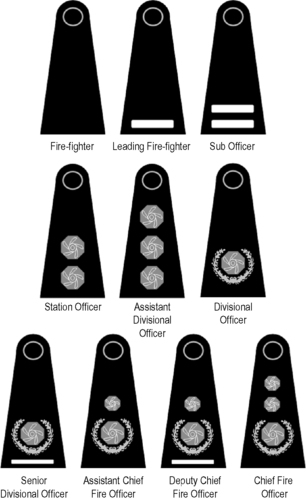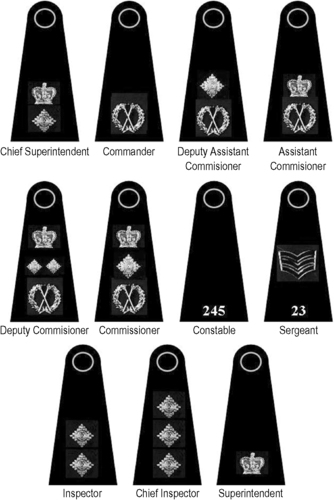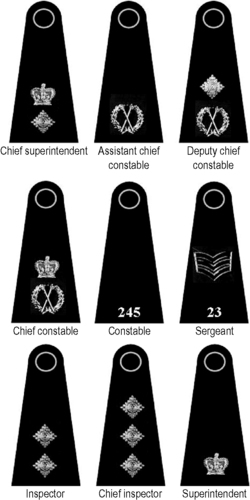Chapter 4. The emergency services
• Ambulance services
• Police services
• Fire services
• HM Coastguard (part of the Maritime and Coastguard Agency)
• Air Sea Rescue
• Mountain Rescue
• Voluntary Aid Societies (St John and St Andrew Ambulance Associations, British Red Cross)
• Volunteer organisations (e.g. British Association for Immediate Care, Women’s Royal Voluntary Service).
The fire and rescue service
Functions of the Fire service:
• Rescue of casualties from fire incidents
• Neutralisation of hazardous materials – chemicals, radiation
• Release of entrapped casualty (transport and industrial accidents)
• Extrication of patients from inaccessible areas (e.g. steep slope rescue)
• Assistance at major incidents (lighting, shelter, personnel for stretcher carry).
Command structure
The Fire service has a formal system of command. When attending an incident involving the Fire service, it is important to identify and speak to the senior officer in order to ensure a coordinated response.
Junior ranks wear yellow helmets, while officers wear white helmets.
The helmets of anyone above the grade of Fire-fighter will also be marked with black bands of varying number and thickness. The greater the number and width of the bands, the greater the seniority.
The rank markings of the Fire service are shown in Figure 4.1.
 |
| Figure 4.1 |
Entrapments
The successful and orderly management of an entrapment can be divided into six phases commonly used by Senior Fire Officers:
• Assessment and making the scene safe
• Stabilisation and initial access
• Glass management
• Space creation
• Access
• Extrication.
An initial assessment of the scene is made on arrival to ensure safety for the patient and any personnel involved in the rescue. On arriving at the scene of an accident, the paramedic should contact the Senior Fire Officer in order to determine whether it is safe to approach the patient.
Incidents involving chemical or radioactive contamination
It is important for ambulance service staff to establish early liaison with the Senior Fire Officer to determine the nature of the hazard and the involvement of any casualties.
It is a responsibility of the ambulance service to provide adequate decontamination facilities for patients.
Although the Fire service has been issued with equipment for mass-decontamination, this is aimed at uninjured survivors.
Major incidents
The primary objectives of the Fire and rescue service at a major incident are shown in Box 4.2. The emergency services will generally adopt a rigid command structure at a major incident. The Gold Commander is usually located away from the incident and maintains a strategic oversight of the incident. The Silver Commander is on-site and delegates specific tasks to the Bronze (or sector) Commanders who are each responsible for a defined area of the incident.
Box 4.2
• Saving life
• Prevention of escalation of the incident (control fires, contain chemicals)
• Protection of rescuers and casualties
• Extrication of casualties, including first aid where necessary, and assistance with movement of the injured to the casualty clearing station
• Control of access and egress from the inner cordon where hazards are existent
• Assistance in investigating the cause of the incident.
The Police service
The primary duty of the police is to uphold the law and to bring to the justice system those who break it. The police will be involved jointly with the Ambulance service in incidents where a crime has been committed such as an assault, a road traffic accident and a major incident (see below).
Command structure
Specialised areas of policing include traffic, firearms teams and air support. Police service rank markings are shown in Figures 4.2 and 4.3.
The crime scene
At a crime scene, the police will be primarily concerned with the preservation of evidence where an offence may have been committed.
The treatment and evacuation of patients from the scene of an incident will inevitably risk disturbing forensic evidence but the preservation of life is the first priority.
Ambulance service staff should therefore be aware of the police requirements to preserve evidence and avoid unnecessary contamination of a crime scene.
Ambulance service staff may subsequently be asked to provide a witness statement as a professional witness.
The police role at major incidents
Police roles at a major incident are given in Box 4.3.
Box 4.3
• Preservation of life
• Emergency services coordination
• Preservation of evidence
• Control of access to the scene
• Identification of the victims
• Removal of bodies of fatalities to mortuary facilities
• Collection of evidence.
HM coastguard
HM Coastguard (part of the Maritime and Coastguard Agency) is accessible through the 999 operator and is the fourth emergency service. In incidents in coastal waters, they have primacy over other services and will take the traditional coordinator role that the police assume on land. Large multi-agency incidents will commonly be coordinated from the regional coastguard headquarters. Primacy is handed back to the police when on land.
Voluntary aid societies
The Voluntary Aid Societies (VAS) (British Red Cross, St John and St Andrew Ambulance Associations) commonly provide care at mass gathering events. Their principal capability is to provide first-aid but the societies will also deploy volunteer nurses, doctors and off-duty ambulance personnel to augment the statutory emergency services.
In the context of a major incident, all voluntary aid society members will be responsible to the Ambulance Commander from the statutory ambulance service, who will determine how VAS staff and VAS ambulances are utilised.
BASICS
The British Association for Immediate Care (BASICS) consists of volunteer doctors functioning independently or in organised schemes to support their local ambulance service. There is no statutory role for this organisation, although some ambulance services rely on these volunteers to assist in the management of difficult cases at the roadside or in the home.
For further information, see Ch. 4 in Emergency Care: A Textbook for Paramedics.







